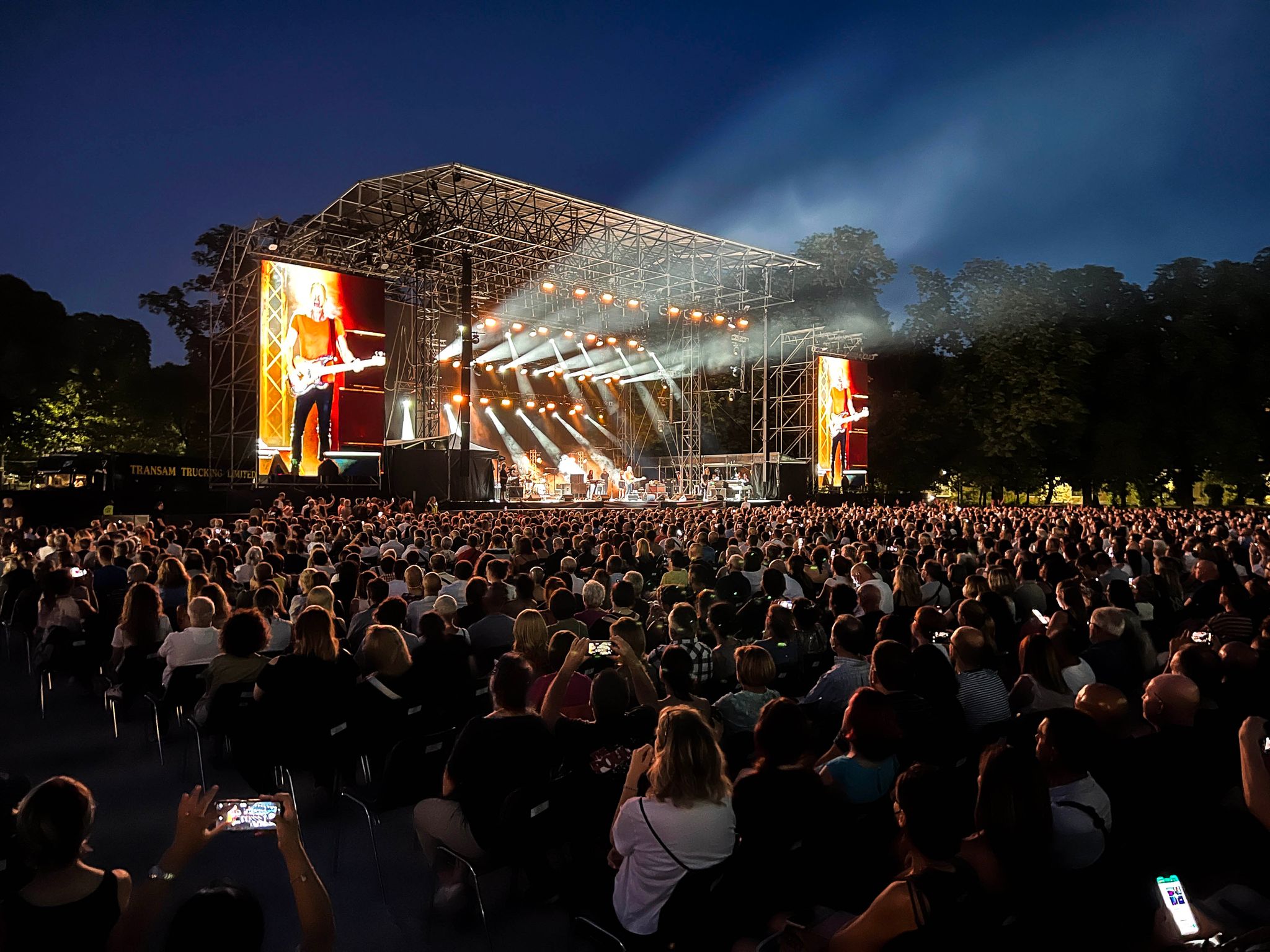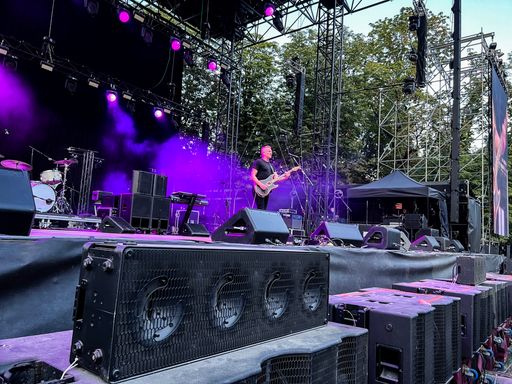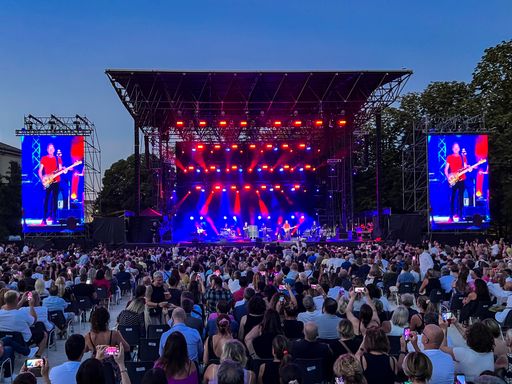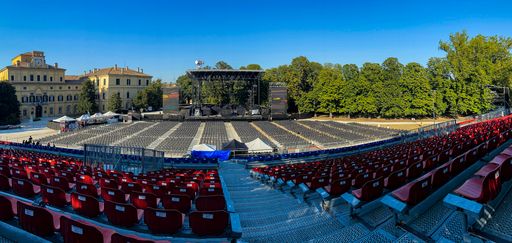
The concert area of Parma’s Parco Ducale hosted a number of prestigious concerts this summer, including performances from Andrea Bocelli, Zucchero, Sting and many others. A K-array Firenze-KH7 system with Firenze-KS8 subs was used for sound reinforcement within the performance space, chosen for its sonic qualities and for the incredible precision available when controlling the sound.
The sound engineers accompanying the artists were impressed by the definition and linearity of the system; a characteristic that allows for focussing and refining individual sounds with even greater precision that works perfectly for venues where complete control is required. The Parco Ducale is a historical park in Parma, covering over 200,000 m2, located in the Oltretorrente district near the Parma river. For the past three years, a concert area with a stage has been set up next to the palace and has already hosted performances by important artists in past editions.
This year's summer calendar has raised the bar even higher, hosting tenor Andrea Bocelli with the orchestra conducted by Beatrice Venezi, alongside Zucchero, Pinguini Tattici Nucleari, Fabri Fibra, Irama and a grand finale with Sting.
A K-array Firenze-KH7 system was used for the events, with its Firenze-KS8 subs, chosen for its homogeneity in diffusion and for the accurate and precise sound control available through digital steering. This was an aspect that proved to be fundamental in reducing noise pollution in a "city" context such as the Parco Ducale, right in the centre of Parma.
The entire system was set up by Riccardo Garbuglio's Arcadia Rent, with the support of Klaus Hausherr, Product Specialist from K-array. In overseeing the project, Klaus assisted all the sound engineers during the festival, stating: "We opted for a relatively standard configuration, with an L+R made up of eight Firenze-KH7 units, ten Firenze-KS8 subs (double 21''), with additional KH7s in a horizontal position with the diffusion pattern rotated as reinforcement for the first rows" said Klaus. Firenze-KH7 is a system that is as simple as it is effective, allowing for precise control over the polar pattern in situations where the loudspeaker is mounted horizontally. This can provide 30° vertical and 100° horizontal dispersion, or 100° vertical and 30° horizontal diffusion with the diffuser rotated. The operation of rotation is immediate and is accomplished simply by turning the mechanism on the front with two fingers, without removing the grille and without the use of tools.
"Having front-fills made up of the same units as the main system, even with the diffusion pattern rotated, offers a definite advantage in terms of sound coherence and simplicity of system set-up," states Klaus.
At the venue, shows were staged with both seated and standing audiences and, precisely for this reason, a sub configuration was conceived from the outset that would provide powerful, homogenous and wide enough coverage to serve de-centralized areas of the venue."We were able to open the spread of the subs up to an angle of 110°, while maintaining excellent pressure throughout the venue. In concerts where there were seated audiences, it was also necessary to provide adequate coverage in the areas to the edges of the stage, which are not always easy to serve," adds Klaus.
"In the areas to the side of the stage, the two Firenze-KH7 side-mounted loudspeakers turned out to be very convenient: with only one box on each side and two cables - signal and power supply. This brilliantly solved the side problem!” Weight is one of the elements that has to be taken into consideration when choosing a system for sound reinforcement. If contained, it can offer tangible advantages.
"To hang each of Firenze-KH7's eight-element clusters, we used simple motors of 500kg capacity each, keeping the overall weight low enough to obtain approval from the Supervisory Commission to use the stage roof directly as an anchor point, which, moreover, underwent a major structural change just two days before assembly. With another traditional system, in all likelihood, this last-minute change would have required redesigning the sound system from scratch, sacrificing on loudspeakers in favour of less weight...” Klaus continues.
For the sake of simplicity, completely analogue signal wiring was chosen, although the Firenze-KH7 can accept a digital signal. Two pairs of cables - signal and power - were used to feed the array, with simple relays of a few centimeters to daisy-chain the other cabinets in the array.
"I run the whole system with one signal for the Left, one for the Right, one line for all the Firenze-KS8 subs, and then one line for the three fronts and two for the sides, for a total of ten OUT lines. In addition, I reserve a final line for the management of another group of subs, not mentioned so far, which have the sole function of rear cancellation to recreate a cardioid configuration. A Galileo processor with six INs is used for control, so as to satisfy the requests of all guest sound engineers who wanted to use separate management systems.”
Out of necessity, the main clusters were hung on the stage and in a decidedly backward position without generating any discomfort to the musicians. In fact, looking at the polar diagram of the Firenze-KH7, it can be clearly seen that the rear lobe, although present, is so narrow that it does not create any problems for anyone standing to the side of the array. During the festival, notable artists and highly experienced sound engineers passed by, finding themselves in front of not just a very high-performance system, but one notably different from those traditionally available on the Pro Audio market. The system has a dynamic responsiveness, together with a coherence in its frequency response, very similar to that typical of studio monitors.
"I don't deny that, at first glance, the system appears different, in shape and size to other systems. For this reason, there are always those who tend to be wary. As soon as I start to play music, regardless of the genre, the first thing that strikes everyone is the incredible linearity and precision across the entire frequency range; an aspect that almost ‘disconcerts' the sound engineers who find themselves with a mix that is rich in detail and definition, almost as if they were mixing on two studio monitors.”
"It's a system that leads you to mix more meticulously, focussing on details that you would probably struggle to discern when using other systems. Here in Parma, we had a restrictive limitation on the sound pressure measured just a few meters from the stage, but despite this the sound and impact was never lacking” concludes Klaus.




